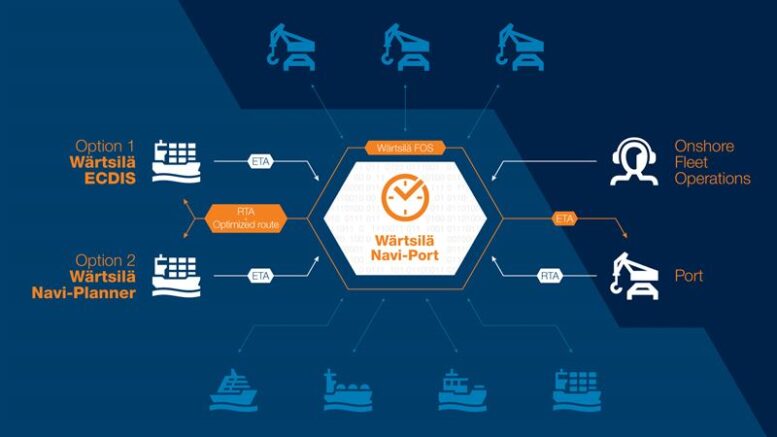At ports around the world, anchored vessels sit in the distance, waiting for permission to dock, resulting in fuel waste, higher carbon emissions, and congestion. Is there a solution to this problem? In most cases, cargo ships arriving at port are assigned a docking space on a first-come-first-served basis. This method of port arrivals has, in effect, created a queueing system that wastes fuel and produces excess greenhouse gas emissions. It’s also a source of increased workload for captains and crews, who work on tight schedules only to sit in congested ports waiting for a berth.
A major source of inefficiency in port arrivals is that ships use “unnecessarily excessive speeds” only to reach port and have to wait for berthing slots or access to piloting or towage, according to Matteo Natali, General Manager of Business Development at Wärtsilä. “Container ships spend on average 6% of their time at anchor waiting for berthing,” says Natali. If a port implements a scheduling system that allocates berths to specific vessels and maintains continuous communication with the vessels to achieve just-in-time arrival, the need to anchor is significantly reduced. Even small changes to a ship’s speed impacts fuel consumption.
An important reason just-in-time sailing has drawn support recently is the maritime industry’s focus on achieving the sustainability goals to reduce greenhouse gas (GHG) emissions set forth by the International Maritime Organization (IMO) for 2050. Reducing the industry’s carbon footprint requires making changes on many fronts. Compared to many other GHG reduction methods, aiming for just-in-time arrival is impactful, cheap, and able to improve operational efficiency if the industry is willing to adapt. While there are emission abatement technologies available on the market, the just-in-time concept optimizes voyages so that unnecessary fuel consumption and emissions are avoided.
Better communication, better planning. Moving away from the current system isn’t easy, however. “For just-in-time arrivals to work, ports need to move to an orchestrated system where berth slots are allotted based on operations and availability,” says Natali. To achieve an optimized system of just-in-time arrivals, ports and vessels need an open platform for transparent communication. While ongoing exchanges of information are crucial to achieving a system of just-in-time arrivals, currently a significant portion of communication in the maritime transport segment occurs via old-fashioned interactions including mail, telephones, and telefax. Wärtsilä technology is revitalizing the outdated methods for an updated and integrated solution. The company recently launched a new data-sharing system called Wärtsilä Navi-Port, a middleware that will be fully integrated with other voyage optimization tools in Wärtsila’s Fleet Operations Solution (FOS) system, according to Natali. “Wärtsilä’s Smart Marine Ecosystem approach is aimed at eliminating wasteful practices in shipping operations, and the Wärtsilä Navi-Port solution does just that,” says Torsten Büssow, Managing Director, Wärtsilä Voyage, in a press release announcing the development.
A solution for all segments. A variety of factors can affect port arrivals and departures, which means that delays must be built into any maritime scheduling system. Navi-Port enables ship-to-shore communication to optimize voyage planning, weather routing, and fuel consumption. With Navi-Port, the designated just-in-time arrival information from ports is sent directly to a ship’s navigation system. Ship Captains receive updates on new recommended times of arrival and can accept changes to optimize speeds for the amended planned time. Navi-Port sends data back to ports to update timetables when a vessel is delayed at sea.
Navi-Port technology has undergone successful testing as part of a joint project between Wärtsilä, Carnival Maritime, and HVCC Hamburg Vessel Coordination Center. Bureau Veritas Marine and Offshore has approved the technology’s cybersecurity protocols. The tests highlighted the impact of just-in-time arrivals on improving efficiency, resource planning, reducing fuel consumption and carbon emissions, and also underscored the importance of just-in-time arrivals for all segments of the maritime industry dedicated to optimizing sustainability solutions. “We are committed to making cruising more sustainable, and to setting an example in greener and safer operations,” Michael Salzmann, Senior Nautical Superintendent at Carnival Maritime says in a press release. “We have tested the Wärtsilä Navi-Port solution with two of our ships, the ‘AidaSol’ and the ‘AidaPerla.’ The ships’ onboard Wärtsilä NACOS Platinum navigation systems were connected directly to Hamburg Vessel Coordination Center, which allowed continuous communications, and in just-in-time arrivals.”
Creating a new mindset. For the Navi-Port technology and a system of just-in-time arrivals to be wholly successful, however, Natali believes that more than technological developments are needed; maritime stakeholders must shift their ways of thinking about the traditional means of operation. In the shipping sector there are certain legacy processes or contractual frameworks that may be impacting the attractiveness of just-in-time sailing. By demonstrating the “unprecedented saving” and other benefits of just-in-time arrivals, Natali believes this new mindset is possible.
“It is essential to create a wide network of connected ports and vessels. While Navi-Port can bring immediate benefits to the ship operators and the port community, the wider the network of connected users, the stronger the value of the system.” Natali says. Navi-Port was built to adapt to the infrastructure and technology in the current fleet. “The key behind Wärtsilä Navi-Port is flexibility and inter-operability – Navi-Port can connect easily to any kind of vessel, navigation system, or port system,” Natali says.
Source: https://www.hellenicshippingnews.com/new-navi-port-technology-to-revolutionise-port-operations/
